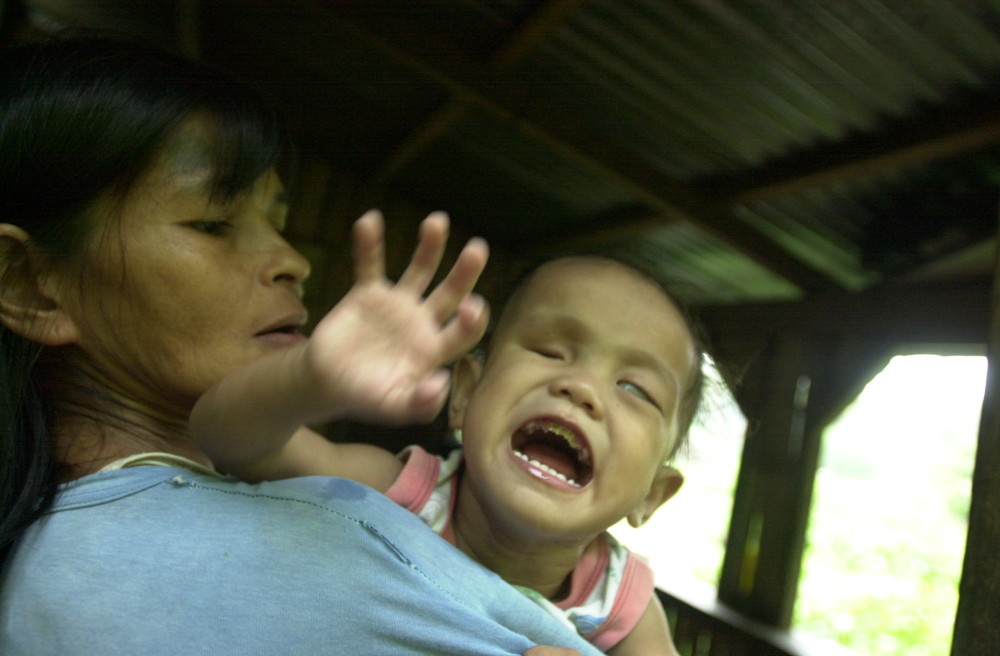The effort to bring genetically engineered crop to developing countries takes a tangled path
Photo by JON NASO/THE STAR-LEDGER
Caption: Angelina tries to soothe her 2-year-old son, Anthony, in the family’s shack in a rain forest in the Philippines, south of Manila. He is blind from vitamin A deficiency brought on by malnutrition that also has left him unable to walk on his own.
In a steamy shack deep in a rain forest, a 2-year-old boy named Anthony is a prisoner of darkness.
Blinded irreversibly from vitamin A deficiency brought on by a poor diet, he must be carried by his mother, lest he slip through the bamboo slats of his stilted hut into the lagoon waters below. Most of the time, he cries.
Anthony weighs 11 pounds. His legs and arms are so poorly developed that he cannot walk on the dark floor of the jungle or anywhere else. He will never see the famed blue twilight of his country, nor the towering green volcanoes that ring his forest.
The family’s woven-bamboo house is just a bit larger than the garden sheds American suburbanites build in their back yards. The family, which does not want to reveal its name for privacy reasons, lives mainly on rice, potatoes, bread and squash.
Angelina, the mother, does her cooking and cleaning when Anthony sleeps. Alex, her husband, fishes for a few hours every day, catching tilapia and ayungin. He can earn a few dollars this way, but it is rarely enough.
Anthony’s 5-year-old sister, Anna, was born with a cleft palate, also caused by vitamin A deficiency.
They are among 100 million children around the world whom a stern and obstinate scientist named Ingo Potrykus wants to help.
SECRET MISSION
It was a year ago when Potrykus settled his 6-foot frame into an airline seat for a 16-hour flight from Zurich, Switzerland, to Manila, three hours northwest of the malarial jungle of Barangay Dolores.
Tucked into his left shirt pocket, obscured by his sport coat, was a sealed white envelope the size of an index card. In the envelope was a most valuable cargo – seeds, controversial, revolutionary, genetically manipulated seeds.
No more than 100 in number, the seeds were the fruits of a decade of research at the Swiss Federal Institute of Technology. Potrykus, a renowned plant biologist, was carrying them to a lab in the Philippines where they were to be transformed from an experimental strain to a real crop with enhanced vitamins.
An earlier shipment had been waylaid by Greenpeace, the environmental protest group, which saw the seeds as a threat to the natural order of things. This time, only Potrykus and his seatmate – colleague Peter Beyer – knew what lay nestled in the envelope.
The seeds were the culmination of a $2-million effort to create an improved variety of white rice. In Potrykus’ shirt pocket was “golden rice,” its normal genetic material spliced with three genes to produce beta carotene, the precursor of vitamin A.
If the experimental rice could be successfully tweaked, bred and brought to market, it could go a long way toward addressing the dire problem of vitamin A deficiency in most of the developing world.
A CAREER CHOICE
Though his reputation is based on it, Potrykus has never seen himself as a genetic engineer. He says he is more of a “wald and wiesen” biologist, a fields-and-meadows type of guy who prefers studying birds, insects and plants over any indoor lab environment.
He became interested in science, he explains, because of its great capacity to yield practical benefits.
“I am not interested in pursuing science for the sake of pure knowledge,” he says. “I realize that makes me different from most other scientists I know.”
Despite this belief, in 1985 Potrykus was invited to join the Swiss Federal Institute of Technology in Zurich – a place filled with scientists in full pursuit of knowledge for knowledge’s sake. His task: to build a new plant sciences institute combining basic and applied research.
The institute, which would eventually grow to house 64 scientists, proved to be the ideal setting for Potrykus’ obsession – to use genetic engineering to contribute to “food security” for developing countries.
The son of a German army surgeon killed during an Allied bombing raid, Potrykus spent most of World War II in northern Bavaria as a teenager dodging the Red Army and foraging for food for his mother and three siblings.
“When you are hungry, you cannot think of anything else,” he says now.
FIGHTING HUNGER
Potrykus started on the problem of world hunger as soon as he settled in a modest lab on the top floor of the Swiss institute in this spotless lakeside city, whose charms were loved variously by Albert Einstein, James Joyce and Vladimir Lenin.
By the time Potrykus set up shop, the first so-called Green Revolution had been a force in the developing world for nearly a decade. It consisted largely of grants from patrons such as the Rockefeller Foundation to scientists to develop new crop varieties with increased yields. The “revolution” met with wild success in some places and dismal failure in others.
With the advent of “green gene” technology in the mid-1980s, it became obvious that a new brand of science could alter the characteristics of plants more rapidly than traditional methods of plant breeding. Genetically engineering rice – the food staple of most of the world’s poor – would be the most fertile line of endeavor, Potrykus reasoned.
“Obviously, to contribute, one would have to work with important crop plants and not only talk about them,” Potrykus said. With Rockefeller scientist Gary Toenniessen, Potrykus began an inquiry into rice biotechnology that would be the most ambitious and amply funded research program ever supported by the Rockefeller Foundation.
With rice as their focus, lab members set out to use the methods of the day for genetic experimentation. They immersed themselves in the painstaking, lengthy techniques needed to genetically alter plants. Five years passed.
Then, in 1990, a researcher working for Potrykus, Swapan Datta, achieved a breakthrough. Using unpredictable techniques that never seemed to work in rice the way they did in other plants, he was able to successfully alter the genes of a rice plant to make it insect-resistant.
A MORE AMBITIOUS GOAL
That accomplishment posed a tantalizing prospect: If scientists could make rice resistant to insects, why not change it so that it would aid the vitamin-deprived? How about vitamin A rice to combat the deficiency causing blindness in half a million children every year?
“It was the equivalent of saying, “Okay, you built a Model T. Now go and build a Porsche’,” said Michael Lawton, a professor of plant science at Rutgers University. “This was tour de force science they were proposing.”
Potrykus and his lab workers were experts at genetically manipulating rice. But it took a fellow researcher named Peter Beyer, a geneticist at the University of Freiburg, to make the science truly useful.
Beyer had met Potrykus on an airplane on the way to a Rockefeller conference on world hunger. A tall man with a crown of tousled brown hair, he and his team had been studying daffodils for more than a decade, and he knew about the genes that produced beta carotene.
TEAMING UP
Beyer and Potrykus agreed to work together, but they had to wait years for a payoff. Some of the methods needed to manipulate rice had to be perfected, from getting rice cells to grow in test tubes to nudging them to develop into full-blown plants. It took even longer to identify the crucial genes involved in the process, let alone insert them one by one into plants.
At 2 a.m. one weekday just before Easter of 1999, Beyer was working in his laboratory. He had taken grains of rice produced in a series of experiments and was removing the brown, fatty outer layer of grain. The grains, he saw, were yellow.
“I couldn’t believe my eyes,” Beyer recalled. “I was alone, so I called my assistant, Salim al-Babili. I woke him up. ‘It’s a miracle,’ I said.”
He sent Potrykus photos of the rice grains via e-mail. “I wrote something like: ‘I’m having something in the attachment you might like,'” Beyer said.
The team had been able to demonstrate, for the first time, that beta carotene could be produced in rice grain through the insertion of three genes – two from daffodils, one from a bacterium. No one else had ever successfully inserted three genes into a plant.
Science magazine accepted the scientists’ account and their work was unveiled at the XVI International Botanical Congress held in St. Louis in August 1999.
Potrykus and Beyer had taken the first step toward their dream – a solution to hunger that could be made available to every poor farmer in his back yard.
However, if achieving the science was complicated, actually using it would prove to be even more so.
A NEW PROBLEM
Beyer and Potrykus started writing up a patent application. But they stumbled across a disturbing fact: The scientists had trampled on 70 different processes or materials in their work, bumping into intellectual property rights belonging to 32 companies and universities.
A patent grants an inventor exclusive rights to an invention for a limited time – including some of the genes and methods used by Beyer and Potrykus. Like a briar patch, those agreements now coiled around one another in ways that business innocents such as Potrykus and Beyer would never unravel.
Unless the legalities could be handled, golden rice would remain a laboratory phenomenon.
“We were naive on this one,” said Toenniessen, the head of food security for the Rockefeller Foundation. “We just didn’t expect it.”
Enter Adrian Dubock.
A career pharmaceutical executive, Dubock met Potrykus by way of looking out for the intellectual property rights of his company, Syngenta, the world’s largest agricultural biotechnology company. The transnational giant, with headquarters in Basel, Switzerland, had U.S. sales of $2.9 billion in 1999. It was created through the 2000 merger of the agricultural division of Novartis with Zeneca Agrichemicals.
As head of mergers and licensing for Syngenta Seeds Inc., Dubock had talked to hundreds of research scientists who had fallen in love with their inventions. He could see that the gene insertion technology invented for golden rice could lead to a wealth of future products, both free and commercialized.
“To me, it was magic,” Dubock said.
Syngenta’s interest in golden rice, like that of other firms, was not entirely altruistic. “Rice is extremely important to us,” said David Evans, head of Syngenta’s research and technology. “It’s one of our strategic crops.”
The technology underlying golden rice holds promise for a lucrative line of business. The rice could be made to contain antioxidants that would fight a number of diseases associated with aging, such as macular degeneration, cardiovascular problems and cancer. Syngenta could see the appeal of such a food for a generation of aging Baby Boomers.
CORPORATE HELP
Potrykus came away thinking he had found his salvation – a corporate shark with a heart. Dubock could speak the language of the corporate world but had spent time in Africa and knew the face of hunger. “It was such a good idea and so important,” Dubock said. “I also knew I could help.”
The pair worked together all through 2000 contacting all the companies with patents they figured were key to the golden rice technology, often appealing to their sense of humanity.
When one company, which Potrykus won’t name, resisted the idea of giving away the rice, Potrykus threatened to drop the whole project. The company came around.
“If I walked away, no one would ever be able to use it,” Potrykus said. “I never really wanted that, but I was not about to allow anyone to charge poor farmers for the rice. Everyone knew I meant it.”
Potrykus, in Zurich, and Dubock, in London, would often meet in Basel at the international airport. Or they would drive over the border into Germany to a restaurant called Schwarzadler, a country-style inn, to map out their strategy. “It was a case of spontaneous sympathy on both sides,” Potrykus said.
The efforts paid off.
Early last January, the press office of the Rockefeller Foundation issued a simply worded release – five major companies had donated intellectual property licenses. They were: Syngenta Seeds AG; Bayer AG, the German health care and chemicals company; Monsanto Co. Inc., the St. Louis-based agricultural giant; Orynova BV in Japan, a joint venture between Japan Tobacco Co. and Syngenta; and Zeneca Mogen BV, a research subsidiary of Syngenta, based in Leiden, Netherlands.
“Watching all of this and seeing the situation, we thought, okay, we can make a difference here,” said Gerard Barry, a top Monsanto scientist who was involved in the negotiations. “This was an extraordinarily worthy scientific achievement that was being stymied. We thought it deserved the opportunity to be tested in the field.”
Each company licensed free-of-charge technology used in the research. In exchange for giving the rice seeds for free to all farmers in the developing world, Syngenta would possess ultimate patent rights on the rice.
“It took a long time, but I think Ingo made a wise decision to involve the private sector,” said Ronald Cantrell, director general of the International Rice Research Institute in the Philippines. “He actually was fighting to make sure that the technology would get to the person that needs it.”
OPPOSITION TAKES ROOT
Critics of big international corporations were not impressed, however.
“By kowtowing to multinationals for fear of infringing their exclusive monopoly patents, public sector researchers surrendered public goods they didn’t need to surrender,” said Pat Mooney of the ETC group in Winnipeg, Canada.
Golden rice may be free. What comes next, he said, won’t be.
Looking back, Potrykus says he may have underestimated the intensity of the coming opposition. This from a man who hid precious seeds in his shirt pocket and grew experimental plants in a grenade-proof greenhouse.
While he had been busy with patent attorneys in Europe and the United States, those opposed to genetically engineered crops had been stoking the controversy in the developing world, questioning the viability of golden rice and the intentions of scientists such as Potrykus.
But a year ago, he and Beyer were content to transfer the seeds from Potrykus’ shirt to his old research partner, Swapan Datta. Datta had moved to the Philippines to head up the rice research program that would combine the seeds with more robust lines of rice.
“It took five minutes to do,” Potrykus said. “And the journey of a lifetime.”
As for the politics of rice, that would be a battle fought on another day. “I don’t mind to fight. Sometimes I like it,” he said.
Copyright © 2000 The Star-Ledger. All rights reserved. Reprinted with permission.



